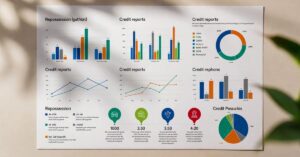When it comes to managing credit card debt, understanding how much over the minimum credit card payment you should pay is key to staying financially healthy.
There’s no universal rule—but one truth remains: The more you pay above the minimum, the faster you’ll get out of debt and the less interest you’ll pay.
Here’s why making just the minimum payment is a costly trap—and how much extra you should aim to pay.
Why Minimum Payments Are Dangerous
Minimum payments are designed to keep you in debt longer.
Let’s break it down:
-
Minimum payments are usually 2%–4% of your total balance
-
A large portion goes toward interest, not the principal
-
Carrying a balance causes you to rack up finance charges every month
Even small balances can take years to pay off if you stick to the minimum. And if you’re still actively using the card, your debt will only grow faster.
Example: The Cost of Paying Only the Minimum
Let’s say you have $2,500 in credit card debt with an 18% APR and a minimum payment of 4% (around $100 to start). If you only make the minimum payments:
-
It will take over 10 years to pay it off
-
You’ll spend more than $1,400 in interest alone
That’s $1,400 you could’ve used for savings, investing, or paying down other debts.
How Much More Should You Pay?
If you can’t pay your balance in full (which is ideal), try to pay 2x to 3x the minimum amount due.
Here’s a simple payment strategy:
-
Minimum payment is $50? Pay $100 to $150 if possible
-
Tight budget? Add just $10–$25 extra per month
Even small additional payments go directly toward the principal, cutting down interest and time.
Use a Credit Card Calculator
Want a wake-up call? Try this free credit card payoff calculator from Bankrate.com. It shows you:
-
How long it will take to pay off your debt
-
How much interest you’ll pay over time
-
The impact of increasing your monthly payment
Why Paying More Matters
Every extra dollar you pay above the minimum:
-
Reduces your balance faster
-
Lowers the interest you’ll pay
-
Shortens your debt timeline
-
Improves your credit utilization ratio
Over time, this helps raise your credit score and reduce financial stress.
Final Thoughts: Break Free From the Minimum Payment Cycle
Credit card minimum payments are designed to benefit the lender—not you. While it may seem manageable in the short term, relying solely on minimums costs you significantly more in the long run.
If you’re working with a limited budget, pay what you can. But if you can afford to pay double or triple the minimum—even occasionally—you’ll cut your payoff time dramatically and keep more money in your pocket.
Image Alt Tag Suggestion:
Person calculating credit card payments with budget worksheet and calculator
FAQs:
What is the typical minimum payment on a credit card?
Most issuers set minimums at 2%–4% of your balance. Some charge a flat minimum (e.g., $25), whichever is greater.
How much should I pay above the minimum?
Aim to pay at least 2–3 times the minimum. Even $10–$25 extra per month can reduce your total interest significantly.
Can paying extra help my credit score?
Yes. Paying more reduces your balance and credit utilization ratio—both key factors in boosting your credit score.
Will I get charged interest if I pay more than the minimum?
Yes, unless you pay the full balance. But paying more reduces future interest by lowering the balance that interest is applied to.
Is it better to pay the minimum on multiple cards or pay one off first?
Use the debt avalanche method (pay more on the highest-interest card) or debt snowball (pay off the smallest balance first). Both help, depending on your financial goals.










